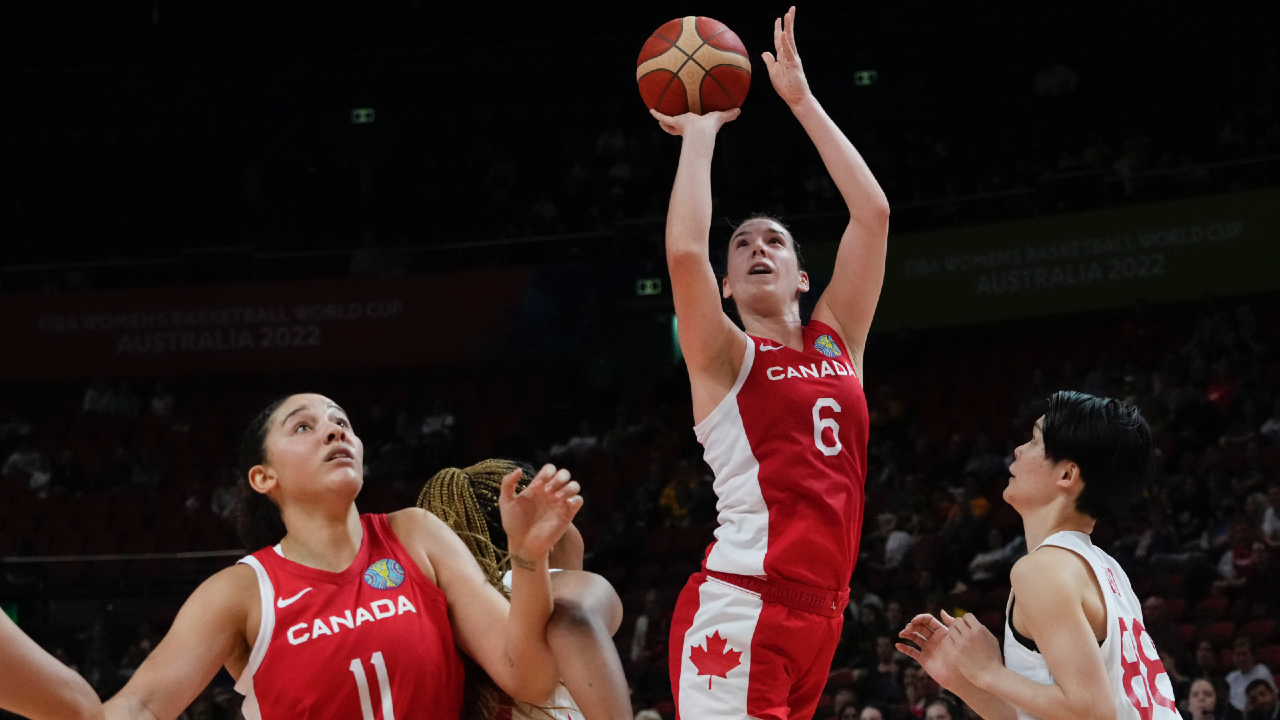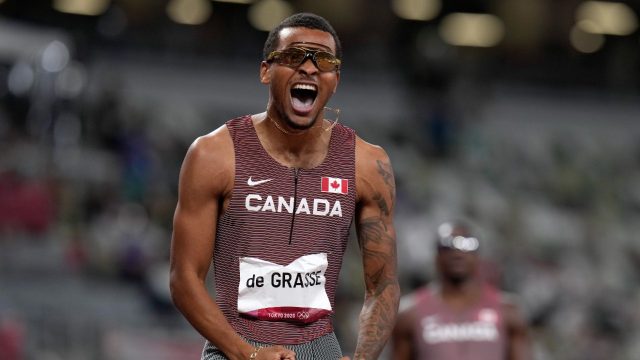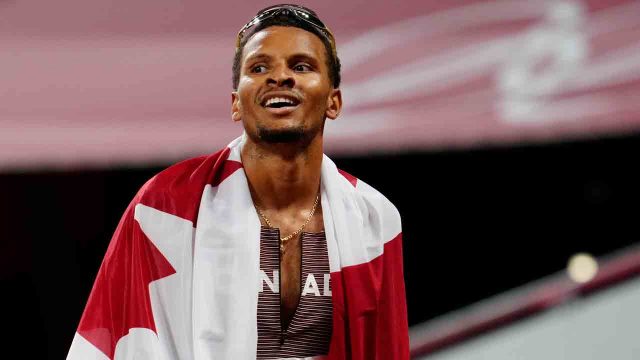
It’s always difficult to learn too much from exhibition games. Coaches aren’t using full rotations, players aren’t always going full-throttle, and there’s an ever-present question of how much both teams should hold back, just in case there’s a rematch down the line.
And exhibitions without three or four key rotation players? You need as many grains of salt as it would take to dry out the Don Valley Parkway this week. Still, Canada’s senior women’s team would probably have preferred a few closer games as they gear up for the 2024 Olympics in France later this month.
Canada steamrolled Portugal, 91-65, in Victoria in late June but dropped a pair of friendlies to Spain (61-48) and Belgium (81-51) last week. Belgium looked like a crisper and faster team than Canada across those games, doing particular damage in the transition game. Head coach Victor Lapeña has had the task of continuing to build on the system the team used during the Olympic qualifiers, while knowing at least a few of these players won’t be big factors once the team’s remaining WNBA players rejoin the group.
That’s not ideal. It’s also not unique to Canada, though they are probably more disadvantaged by the absence of their WNBA standouts than any country other than the United States or Australia. The WNBA schedule hits a pause after the games on July 17 — with the exception of the Team WNBA vs. USA Women’s National Team All-Star Game on July 20 — to allow players to join their national programs. That means Canada will have Bridget Carleton, Aaliyah Edwards and Kia Nurse back with the team for their final tune-ups. Pretty big deal! Laeticia Amihere, meanwhile, was granted leave by Atlanta so she could join the team early and has been participating in exhibitions.
What follows are the details you need ahead of the women’s tournament. You can find the men’s early preview here.
How they got here
If Canada earns a medal in the Olympics, Spain may ask for a producer credit.
Back in February at the Olympic Qualifying Tournament in Sopron, Hungary, Canada’s fate was in Spain’s hands. Canada had gone 1-2 in the round robin of the event, beating the host Hungary but losing to Spain and Japan. While a bit disappointing, it wasn’t entirely unexpected. Hungary upsetting Japan, however, was unexpected, and it set up a win-and-your-in scenario for Hungary in the tournament’s final game. Spain had nothing to play for, yet managed a 22-point comeback to defeat Hungary 73-72, sending Canada through to the Olympics for the fourth consecutive games.
They don’t (often) ask how you got there, just whether you did. A somewhat shorthanded Canadian team didn’t play particularly well, struggling with late-game execution throughout, but strong performances from Kayla Alexander, Bridget Carleton, soon-to-be four-time Olympian Natalie Achonwa, Shay Colley and Amihere, along with a taste of major tournament play for Syla Swords, were all positives to build on.
Final exhibitions
Canada has a pair of tune-ups still to go, travelling to Spain next week before arriving in France for the main event. They will play Australia on July 23 at noon ET and Spain on July 24 at 2 p.m. ET, two incredibly valuable matchups against strong competition. Both games will be available to stream on CBC Gem.
(Side note: The men’s final exhibitions will also be streaming on CBC Gem. They go down on July 19 at 3:10 p.m. ET against France and July 21 at 12:30 p.m. ET against Puerto Rico.)
The roster
Canada announced its 12-woman roster on July 2.
Already in camp/exhibitions: Achonwa, Alexander, Colley, Yvonne Ejim, Nirra Fields, Sami Hill, Cassandre Prosper, Swords
Early WNBA additions: Amihere
Late WNBA additions: Carleton, Edwards, Nurse
Canada’s group-stage opponents
Based on betting lines and FIBA rankings — a helpful guide but hardly gospel — Canada’s group is the second-strongest of the three. Group C being considered the strongest is almost entirely due to the projected dominance of the United States, as Germany is the lowest-rated team in the event and Japan and Belgium are around the quality of Canada, in recent history. Australia and France are generally considered to be two of the three or four strongest teams in the event, and betting lines show them as the likeliest teams to upset the U.S. (though they put the odds of that extremely low).
Australia, the world’s No. 3-ranked program, sent a strong message at their qualifying tournament in Belem, sweeping their group with a plus-40 point differential. While they “only” made the quarters in the past two Olympics, they were regular medallists for decades before that and have medalled in three consecutive World Cups. They have more WNBA players than any non-U.S. team, and while that’s not everything in FIBA play, the talent level speaks for itself. Ezi Magbegor and Alanna Smith are the standout names from the WNBA side, Tess Madgen is the player to gameplan for out of the Australian WNBL and Lauren Jackson brings a fascinating story as a five-time Olympian at age 43. The Opals are led by the coach of the New York Liberty, Sandy Brondello.
France, meanwhile, will be looking for their third podium finish in the last four Olympics and their fourth consecutive advance to the semis or further. There are few programs who boast the consistency that France does, and any concerns that they’ve slowed down just a touch (seventh in the 2022 World Cup, third in 2023 Eurobasket) were probably eased when they destroyed China and Puerto Rico at qualifiers back in February, despite already having their ticket punched. Marine Johannès and Gabby Williams will be the familiar names — Johannès could be a nightmare matchup — and Dominique Malonga will be a marquee name ahead of the 2025 WNBA Draft. There is a very deep roster behind them, one that’s made up exclusively of international players who have had serious time to train together leading up to this event.
Nigeria still hasn’t named a final roster of 12, as of this writing, but their preliminary roster included the return of Ezinne Kalu, which would be a big boost to their backcourt play. While not as well-known as the other teams in this group, Nigeria has dominated the Africas zones with four consecutive AfroBasket victories and worked its way up to a No. 12 world ranking. While they withdrew from the 2022 World Cup, limiting our recent looks at them, they made the 2018 World Cup quarterfinals, gained Olympic experience from 2020 and managed to qualify in February by defeating Senegal (before blowout losses to the U.S.A. and Belgium).
Canada’s schedule
Canada’s round-robin schedule is as follows:
July 29 vs. France, 11:15 a.m. ET
Aug. 1 vs. Australia, 7:30 a.m. ET
Aug. 4 vs. Nigeria, 7:30 a.m. ET
Quarters: Aug. 7
Semis: Aug. 9
Final: Aug. 11
The rest of the Olympic field
The U.S. received an automatic berth as the 2022 World Cup winners, while France was granted a spot as the host country. Unlike the men’s qualification, those were the only berths locked in before February’s Olympic Qualifying Tournaments, which saw the final nine teams qualify across four different events. The field of 12 includes five teams from the European zone (Spain, Serbia, France, Germany, Belgium), three from the Americas (Canada, U.S.A., Puerto Rico), two from Asia (Japan, China) and one each from Africa (Nigeria) and Australia, who have historically been a part of an Oceania zone that’s been folded into Asia qualifying events the last few years.
Group A: Spain, Serbia, China, Puerto Rico
Group B: Canada, Australia, France, Nigeria
Group C: United States, Germany, Japan, Belgium
The United States are heavy, heavy favourites to win it all, with France and Australia next-best favoured to medal and China, Belgium, Spain, Japan and, to a lesser extent, Canada making up the next tier.
Olympic format
The quality of your group matters for two reasons. First, the top two teams in each group move on to the knockout stage; obviously, winning games is key. Second, the top two third-place teams also advance; if you can’t win outright, you need to maximize your point differential for a possible cross-group tiebreaker.
There should always be pressure to win as many games as possible, outright, but Canada is in a position where a focus on point differential could be necessary, too. Group C would, on paper, project to have the worst point differentials at the bottom of the group due to potential U.S.A. blowouts, so Group A and B teams that don’t sweep their pool will want to keep losses as close as possible and run up the score in wins where they can.
The quarterfinal matchups will be determined by a draw based on pots teams are put into, rather than automatically assigning teams into knockout slots based on where they finish. The advancing teams are ranked first through eighth based on record and point differential, at which point quarterfinal matchups will be set based on those rankings to separate teams from their initial groups.
Women’s 3×3
In addition to the traditional 5-on-5 game, Canada’s women qualified in the 3×3 event as well, which is a really exciting brand of basketball, if you haven’t caught it yet. You can win those games by either being the first to 21 or, if things are lower scoring, being ahead after 10 minutes. It makes for a fun pace and some serious clutch moments.
After playing their way in via an Olympic Qualifying Tournament in May, Kacie Bosch, Katherine and Michelle Plouffe, and Paige Crozon now get the chance to be the first 3×3 team to ever represent Canada at the Olympics.The eight qualified teams will play a full round-robin, with the top two seeds earning byes to the semis and teams three-through-six making a modified quarterfinal. It’s a knockout format from there, with as many as 10 games between July 30 and Aug. 5.






